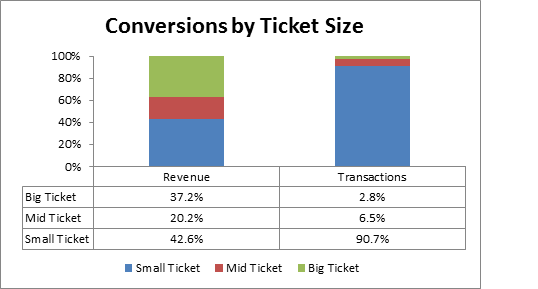Size Does Matter: How Retailers Should Manage Campaigns For Big & Small Ticket Items
Big retailers with a substantial store presence most often have a big online presence with thousands of SKUs. Apart from drawing consumers who might solely look online to buy products, they also help consumers in the earlier research phase of the buying cycle. Sometimes, the merchant will complete a transaction online that might have otherwise […]
Big retailers with a substantial store presence most often have a big online presence with thousands of SKUs. Apart from drawing consumers who might solely look online to buy products, they also help consumers in the earlier research phase of the buying cycle. Sometimes, the merchant will complete a transaction online that might have otherwise happened in the store.
An SEM manager for such a retailer is often faced with several campaign management questions.
Should the merchant focus on drawing more volume from small ticket items or from sparse but high value big ticket items? If she is tasked with profit maximization should she look at keyword performance for all keywords the same way? Do her customers first search online then purchase offline or vice versa?
As I analyzed a large amount of transactional data, I first classified the transactions in the categories of small, mid and big ticket items. Small ticket items were those that had an order size between $1 and $300, mid ticket $300 to $1000 and big ticket items are above $1000. When classified this way, the revenue and transactions break up as shown below.
Small ticket items contribute to 91% of all transactions but only 43% of revenue. Big ticket items on the other hand contribute only 3% of all transactions but 37% of all revenue. Clearly, while big ticket items are small in number, they are big revenue drivers.
When a marketer tracks daily transactions coming from small and big ticket items, another pattern becomes very apparent. Small, mid and big ticket items are statistically different in behavior. Small ticket items, show a definite pattern: Strong performance on Mondays, decreasing steadily over the remainder of the week.
The difference between best and worst performance over this time period was 25%. Mid-ticket items exhibit more variance but is quite steady. Big ticket on the other hands exhibit significant volatility. The best performance in this time period was over $130,000 while the worst performance was $20,000, over a 6x difference.
To use a football example, small ticket items are like your trusty running back, plowing through in every play getting a few yards, while the big ticket items are like the temperamental star wide receiver who can make huge plays but also fumble the ball.
Keyword Management Tips
Just as people with varying temperaments should be managed differently, keywords for small, mid and big ticket items should be managed with a different mindset.
Keywords relating to small and mid ticket items should be managed tightly with a shorter look back window. They exhibit low variance and steady performance and hence one would do well to apply short term reactive approach in managing them.
Keywords relating to big ticket items will deliver but they will take more time on average. They also exhibit a lot of performance variance and hence might burn through a lot of cash before making that big conversion that makes it worth the effort.
Ideally, they should be managed with sophisticated statistical models but if you are using spreadsheets to manage these keywords, I would suggest using significantly longer lookback windows. You would be prudent to err on the side of bidding aggressively on these keywords taking a short term loss in exchange for a big long term gain.
This analysis opens up many questions on the behavioral side. Is there is a relationship between order size and time between click and conversion? Do people exhibit sensitivity to certain price points?
All this and much more in my next post.
Contributing authors are invited to create content for Search Engine Land and are chosen for their expertise and contribution to the search community. Our contributors work under the oversight of the editorial staff and contributions are checked for quality and relevance to our readers. The opinions they express are their own.
Related stories

